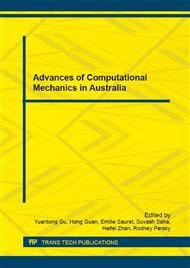p.541
p.547
p.553
p.559
p.565
p.571
p.577
p.583
p.589
Wear Particle Analysis and the Evolution of the Plastically Deformed Layer on Australian Rail Steel
Abstract:
Particle analysis methodology is presented, together with the morphology of the wear debris formed during rolling contact fatigue. Wear particles are characterised by their surface topography and in terms of wear mechanism. Rail-wheel materials are subjected to severe plastic deformation as the contact loading progresses, which contributes to a mechanism of major damage in head-hardened rail steel. Most of the current methodologies involve sectioning of the rail-wheel discs to trace material damage phenomena such as crack propagation and plastic strain accumulation. This paper proposes methodology to analyse the development of the plastically deformed layer by sectioning wear particles using the focussed ion beam (FIB) milling method. Moreover, it highlights the processes of oxidation and rail surface delamination during unlubricated rolling contact fatigue.
Info:
Periodical:
Pages:
577-582
Citation:
Online since:
July 2016
Keywords:
Price:
Сopyright:
© 2016 Trans Tech Publications Ltd. All Rights Reserved
Share:
Citation:


